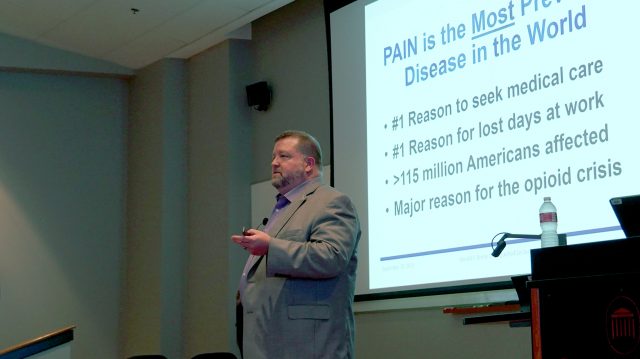
Christopher McCurdy delivers the inaugural Ronald F. Borne Endowed Lecture in September at the School of Pharmacy. McCurdy helped develop pain-imaging technology during his time as a researcher at Ole Miss that has now been licensed for further development by pharmaceutical company PainVox. UM photo by Sage McNamara
OXFORD, Miss. – A University of Mississippi-invented technology focused on imaging chronic pain has been exclusively licensed for further development by pharmaceutical company PainVox.
The first-of-its-kind radiopharmaceutical, or radiotracer, has the potential to identify precise origin sites of chronic pain across a number of conditions.
“We are thrilled to have PainVox as a partner and look forward to the continued development of this important radiotracer,” said Donna Strum, dean of the School of Pharmacy. “The ability to image chronic pain opens the door for a new field in which chronic pain is localized and quantifiable.
“Once we have such a tool, there are broad implications for therapeutics.”
Every year, 50 million people in the U.S. suffer from debilitating chronic pain, according to the Centers for Disease Control and Prevention. One-third of those experience serious impediments to their quality of life and ability to work.
Specifically, chronic pain can contribute to depression, anxiety, poor sleep patterns, decreased quality of life and substance use disorder, which can lead to higher suicide risk, lost work productivity, disability and increased health care costs, according to the U.S. Department of Veteran’s Affairs.
“For half of chronic pain patients, doctors cannot accurately pinpoint the origin sites of pain generation,” said Dave Singhal, PainVox CEO and medical imaging expert. “This results in doctors sometimes relying on problematic treatments: ineffective surgeries, best-guess injections and drugs with high risk of abuse.
“PainVox is working to address these deficiencies in the existing standard of care in pain diagnosis.”
The radiotracer was developed to tackle these concerns. It works by injecting molecules with a radioactive tag into the body that attach to receptors linked to inflammation and pain. These areas then “light up” on a PET-MRI scan and guide doctors to the source, or sources, of pain, enabling them to offer more targeted treatment options.
“Many patients have undergone multiple treatment options, multiple surgeries and many imaging and diagnostic techniques where they haven’t been able to be treated or relieved of their pain,” said Christopher McCurdy, who helped develop the technology as an Ole Miss pharmacy professor and researcher.
“In many cases, these individuals are totally out of options – some of them have been told that this is all in their head and nothing can be done for them.”
“An ability to image chronic pain and provide localized and quantifiable targets for intervention would radically change the field,” Singhal said. “We are interested in working with partners who can see a future in which chronic pain can be resolved for most patients.”
Dr. Sandip Biswal, professor of radiology at the University of Wisconsin-Madison, was a pioneer in the development of the technology.
“I believe the ability to image chronic pain sources and provide localized and quantifiable targets for intervention will radically change the field, leading to a future in which chronic pain can be resolved for most patients,” Biswal said.
McCurdy has dedicated his life’s work to developing drugs that treat substance abuse and pain. Now a professor in the Department of Medicinal Chemistry at the University of Florida, McCurdy recently returned to Ole Miss to give the inaugural Ronald F. Borne Endowed Lecture, in which he highlighted this technology.
“This really could impact chronic pain patients more than any technology we’ve seen up to this point,” McCurdy said. “Even if we could address 10% of the Americans who have chronic pain, that’s 5 million people. There is a large population of people who are in dire need of some form of intervention – many of whom are unable to do what they want to do in life.
“We believe in its potential as a diagnostic tool that will help physicians improve quality of life and direct pain treatments in a totally new manner.”
PainVox’s mission is to accelerate development of solutions by collaborating with expert teams of scientists and industry leaders to transform diagnostics, localization and treatment determination for those patients most affected by chronic pain syndrome. The company has locations in Mississippi and California.
